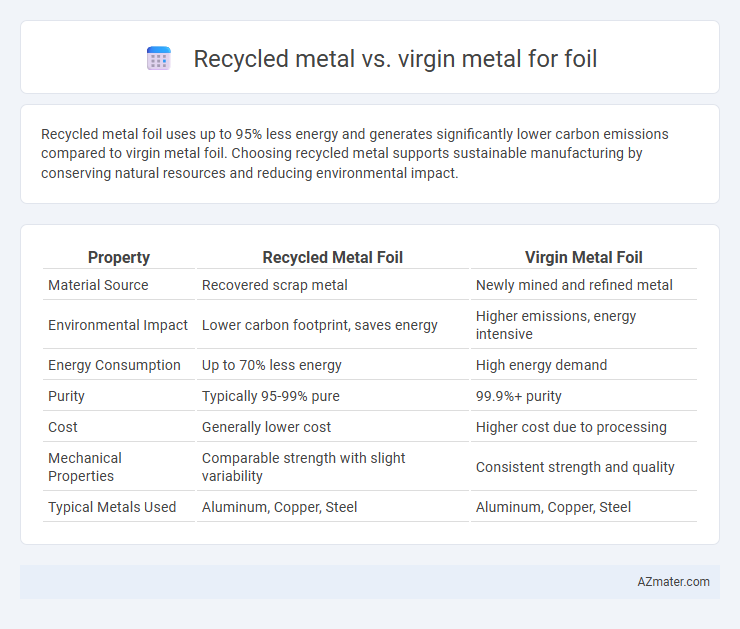Recycled metal foil uses up to 95% less energy and generates significantly lower carbon emissions compared to virgin metal foil. Choosing recycled metal supports sustainable manufacturing by conserving natural resources and reducing environmental impact.
Table of Comparison
| Property | Recycled Metal Foil | Virgin Metal Foil |
|---|---|---|
| Material Source | Recovered scrap metal | Newly mined and refined metal |
| Environmental Impact | Lower carbon footprint, saves energy | Higher emissions, energy intensive |
| Energy Consumption | Up to 70% less energy | High energy demand |
| Purity | Typically 95-99% pure | 99.9%+ purity |
| Cost | Generally lower cost | Higher cost due to processing |
| Mechanical Properties | Comparable strength with slight variability | Consistent strength and quality |
| Typical Metals Used | Aluminum, Copper, Steel | Aluminum, Copper, Steel |
Introduction to Foil Production: Recycled vs Virgin Metal
Foil production relies heavily on the choice between recycled metal and virgin metal, which significantly impacts environmental sustainability and material quality. Recycled metal reduces energy consumption by up to 95% compared to virgin metal extraction, lowering the carbon footprint of foil manufacturing. Virgin metal offers superior purity and structural integrity, essential for producing high-performance aluminum foil used in sensitive applications like food packaging and electronics.
Defining Recycled Metal and Virgin Metal in Foil Manufacturing
Recycled metal in foil manufacturing refers to aluminum or other metals that have been reprocessed from scrap materials, reducing the need for raw ore extraction and lowering environmental impact. Virgin metal is newly mined and refined aluminum or metals that have not undergone previous manufacturing cycles, ensuring maximum purity and consistent quality for foil production. The choice between recycled and virgin metal affects the foil's physical properties, cost efficiency, and sustainability profile in industrial applications.
Energy Consumption: Recycled Metal vs Virgin Metal Foil
Recycled metal foil consumes up to 95% less energy compared to virgin metal foil, significantly reducing the carbon footprint during production. Energy savings stem from eliminating the need for mining, refining, and smelting raw ores, processes known for their high energy demands. Utilizing recycled metals thus supports sustainable manufacturing by lowering overall energy consumption and greenhouse gas emissions.
Environmental Impact Assessment
Recycled metal foil significantly reduces environmental impact by consuming up to 95% less energy compared to producing virgin metal, leading to lower greenhouse gas emissions and reduced mining-related habitat destruction. Life cycle assessments demonstrate that recycled metal minimizes raw material extraction, decreases water usage, and lowers toxic waste generation, making it a more sustainable choice for foil production. This environmental advantage supports circular economy principles by encouraging resource efficiency and reducing landfill waste.
Cost Comparison: Recycled vs Virgin Metal Foil
Recycled metal foil offers significant cost savings compared to virgin metal foil due to lower raw material expenses and reduced energy consumption during processing. Virgin metal foil typically incurs higher costs because of mining, refining, and smelting processes that require more energy and resources. The price difference can be substantial, making recycled metal foil a more economical option for manufacturers focused on budget and sustainability.
Quality and Performance Differences
Recycled metal foil often exhibits slightly altered properties compared to virgin metal foil due to the presence of trace impurities, which can affect its ductility and strength. Virgin metal foil generally provides superior uniformity and enhanced mechanical performance, resulting in better heat resistance and barrier properties for packaging applications. While recycled foils are environmentally favorable, industries requiring precise quality standards often prefer virgin metal foil for consistent performance.
Supply Chain and Availability
Recycled metal foil offers improved supply chain sustainability by reducing dependence on finite natural resources and lowering environmental impact compared to virgin metal foil. Availability of recycled metal fluctuates with collection rates and recycling infrastructure efficiency, potentially causing supply inconsistencies in foil production. Virgin metal foil supply remains more stable due to established mining and refining operations but faces increased volatility from geopolitical risks and resource depletion.
Industry Standards and Certifications
Recycled metal foil must meet strict industry standards such as ISO 14021 for environmental labeling and ASTM E30 for sustainable materials in packaging, ensuring reduced carbon footprint and resource conservation. Virgin metal foil adheres to certifications like ASTM B221 ensuring high purity and mechanical properties crucial for electrical and thermal conductivity. Manufacturers often obtain certifications from organizations such as UL and SGS to verify compliance with both recycled content and performance criteria, promoting transparency and quality in foil production.
Market Trends and Consumer Preferences
Recycled metal foil is gaining significant traction in the packaging industry due to increasing consumer demand for sustainable and eco-friendly products, driven by growing environmental awareness and stricter regulatory frameworks. Market trends indicate a rising preference for recyclable and cost-effective recycled metals, which reduce carbon footprints and energy consumption compared to virgin metals. Companies adopting recycled metal foil benefit from competitive advantages through enhanced brand reputation and alignment with global sustainability goals, reinforcing the shift away from virgin metal usage.
Future Outlook for Sustainable Foil Production
Recycled metal significantly reduces energy consumption and carbon emissions compared to virgin metal, making it the preferred choice for sustainable foil production in the future. Increasing advancements in metal recovery technologies and circular economy practices are projected to drive higher recycled content in foil manufacturing. With rising environmental regulations and consumer demand for eco-friendly packaging, the foil industry is poised to shift towards predominantly recycled metals to minimize ecological impact.

Infographic: Recycled metal vs Virgin metal for Foil
 azmater.com
azmater.com